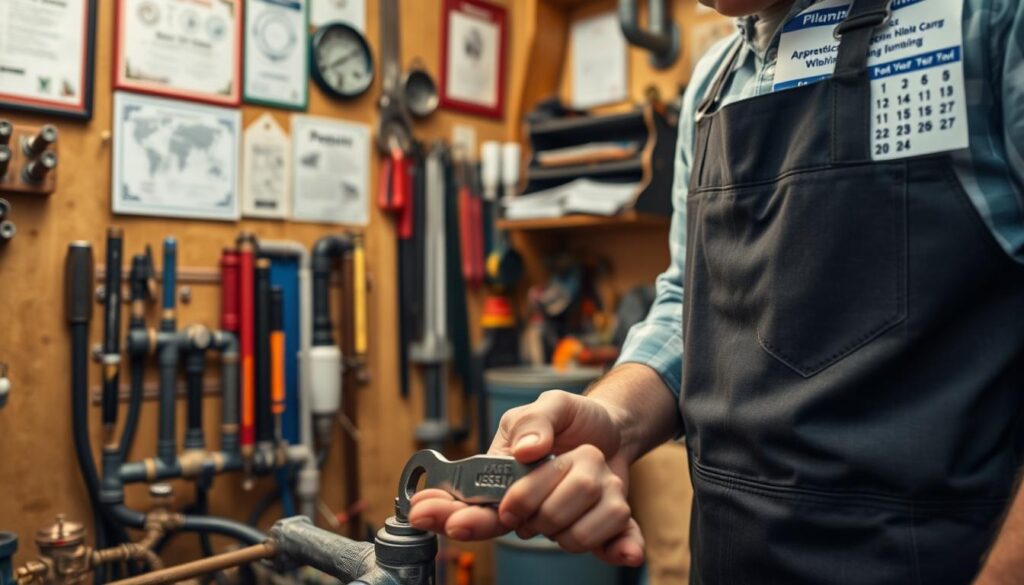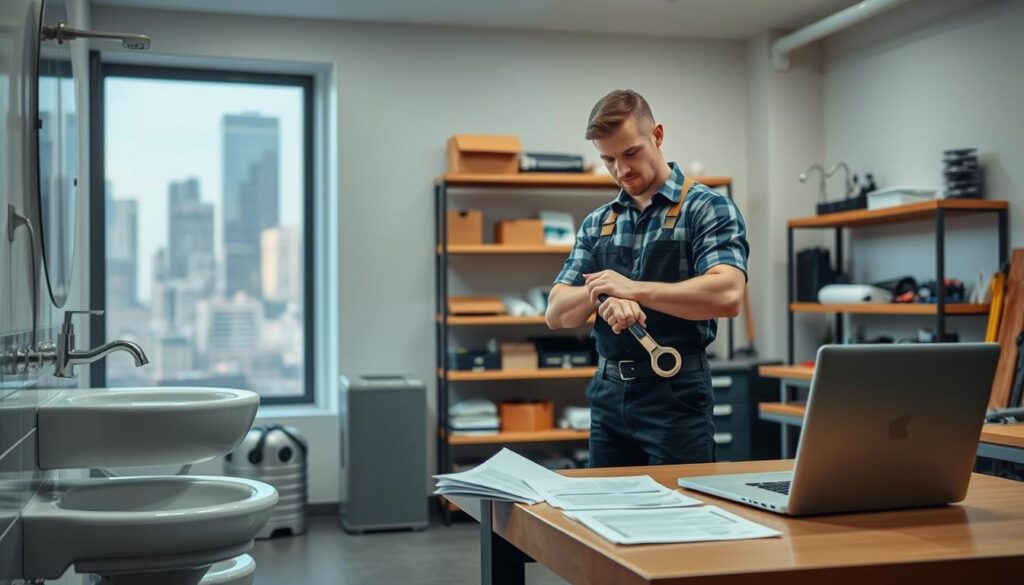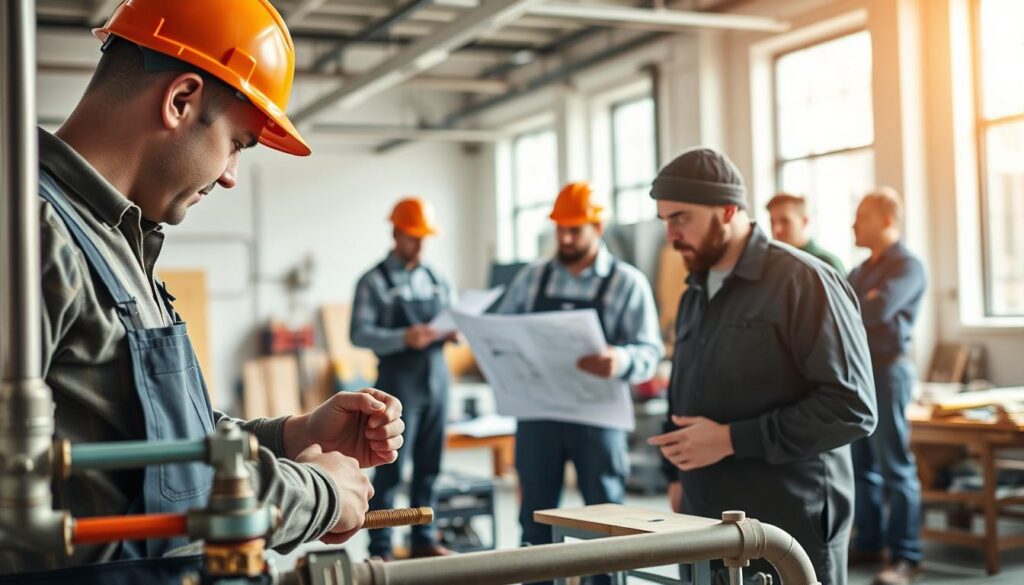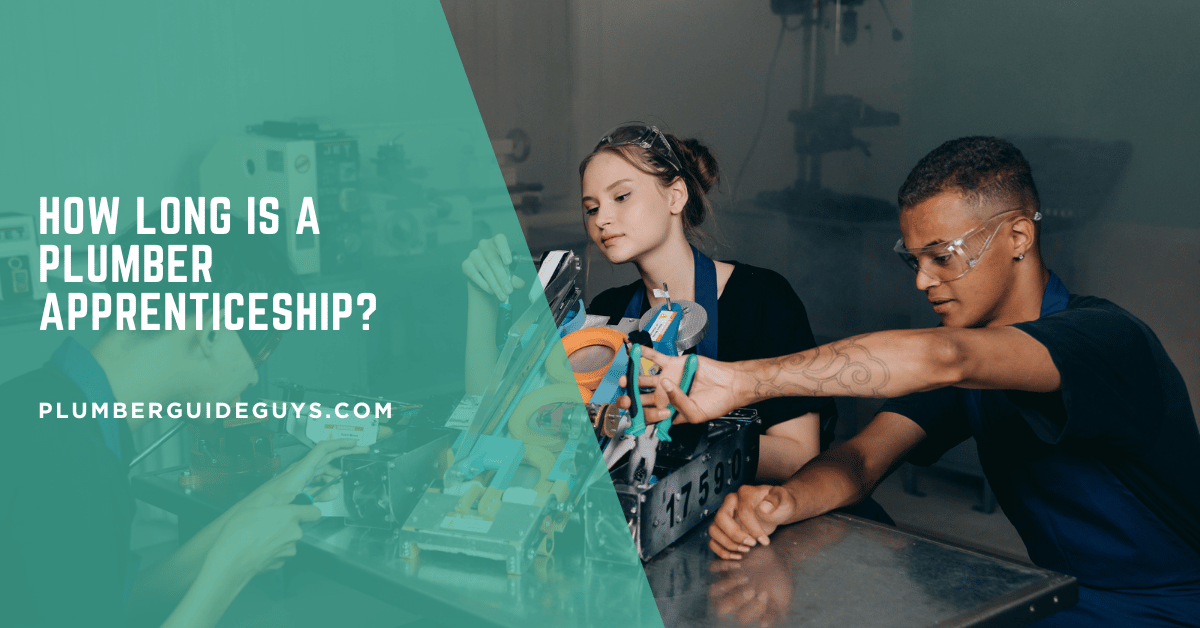Affiliate Disclosure
Plumber Guide Guys is a participant in the Amazon Services LLC Associates Program, an affiliate advertising program designed to provide a means for sites to earn advertising fees by advertising and linking to Amazon.
How Long is a Plumber Apprenticeship? Did you know over 76% of skilled plumbers in the U.S. start through apprenticeships? Knowing how long a plumber apprenticeship lasts is key for those thinking about this trade.

A plumbing apprenticeship is a detailed way to become a professional plumber. It usually lasts 4-5 years, mixing hands-on training with classroom learning. You’ll go from a beginner to a skilled pro, ready for tough plumbing tasks.
Your apprenticeship will include lots of practical work and learning. You’ll work with seasoned plumbers, learning skills that books can’t teach. This way, you’ll get the skills needed to thrive in plumbing.
Key Takeaways
- Plumber apprenticeships typically last 4-5 years
- Programs combine on-the-job training with classroom instruction
- Apprentices learn from experienced professional plumbers
- Certification is required to become a licensed plumber
- Apprenticeship programs provide structured career development
Table of Contents
Overview of Plumbing Apprenticeship Programs
Plumbing apprenticeship programs are a great way to become a professional plumber. They mix hands-on experience with classroom learning. This creates a strong foundation for those starting in the trade.
The training timeline is designed to prepare you for the plumbing world. Apprenticeships usually last several years. This lets you dive deep into plumbing systems and techniques.
What is a Plumbing Apprenticeship?
A plumbing apprenticeship is a paid program that teaches you through work and classes. You’ll work with experts and learn in school. This way, you get both practical and technical skills.
Basic Requirements to Start
- Minimum age of 18 years
- High school diploma or GED equivalent
- Physical fitness to perform demanding manual labor
- Basic math and reading comprehension skills
- Valid driver’s license
Program Structure Overview
The apprentice plumber program length typically involves:
| Training Component | Hours/Duration |
|---|---|
| On-the-Job Training | 6,000-8,000 hours |
| Classroom Instruction | 144-180 hours per year |
| Total Program Duration | 4-5 years |
Being a plumbing apprentice is both tough and rewarding. By joining this program, you’ll gain the skills to excel in plumbing.
How Long is a Plumber Apprenticeship
Understanding the length of a plumber apprenticeship is key for those thinking about this career. Plumbing apprenticeships are detailed training programs. They aim to turn aspiring professionals into skilled tradespeople.
On your journey to become a licensed plumber, you’ll follow a structured path. Most programs last about 4-5 years. This time is spent in both on-the-job training and classroom learning.
Standard Program Duration
There are two main parts to becoming a licensed plumber:
- Extensive on-the-job work experience
- Comprehensive classroom instruction
Apprenticeships usually need around 8,280 hours of hands-on work experience. This is paired with about 720 hours of technical education.
Breakdown of Training Hours
The years to become a licensed plumber are structured:
- First-year apprentices complete roughly 1,500-2,000 total training hours
- Subsequent years involve progressively advanced training
- Final years focus on specialized skills and professional certification
Factors Affecting Timeline
The exact time for your plumbing apprenticeship can change based on several factors:
- State-specific licensing requirements
- Individual learning pace
- Availability of training programs
- Specific employer apprenticeship structures
Remember, your commitment and hard work can speed up your apprenticeship.
On-the-Job Training Components
Your plumber training timeline is filled with hands-on learning. It turns book knowledge into real skills. During your apprentice plumber program, you’ll gain key skills through real-world work.
On-the-job training is the heart of your plumbing apprenticeship. You’ll work with seasoned pros who teach you through real tasks.
- Learn pipe installation techniques
- Practice fixture setting and repair
- Develop troubleshooting capabilities
- Understand safety protocols
Your apprenticeship will grow your role over time. First, you’ll watch and help senior plumbers. Later, you’ll tackle big projects on your own.
“Mastering plumbing isn’t just about technical skills, but understanding the craft’s nuances through practical experience.” – Master Plumber Association
Important skills you’ll learn include:
- Residential system installations
- Commercial plumbing infrastructure
- Advanced diagnostic techniques
- Specialized equipment operation
The plumber training timeline is usually 4-5 years. You’ll need about 8,000 to 10,000 hours of training. Your progress depends on mastering skills and showing steady growth.
Classroom and Technical Training Requirements
Trade school plumbing programs offer in-depth theoretical training. This training goes hand-in-hand with practical apprenticeship experience. You’ll learn in structured levels, each adding vital knowledge for your plumbing certification.
During your apprenticeship, you’ll get technical education to become a skilled plumber. The training has three main classroom levels.
Level 1 Course Requirements
Your first training covers basic skills and safety. You’ll learn about:
- Workplace safety protocols
- Introduction to plumbing tools and equipment
- Basic blueprint reading
- Mathematics for plumbing calculations
Level 2 Course Requirements
The second level dives deeper into technical knowledge. You’ll study:
- Advanced pipe fitting techniques
- Residential and commercial plumbing systems
- Local and national plumbing codes
- Drainage and water distribution principles
Level 3 Course Requirements
The final level prepares you for tough professional challenges. You’ll learn about:
- Complex system design
- Advanced troubleshooting methods
- Specialized installation techniques
- Professional project management
Each training level needs 144-180 classroom hours. This ensures you develop all the skills needed for your apprenticeship.
“Knowledge is the foundation of exceptional craftsmanship in plumbing.” – Professional Plumbing Educators Association
Essential Skills and Knowledge Development
Learning essential skills is key during your plumber training. You’ll become a skilled professional by mastering technical and interpersonal skills. These skills are vital for your success in the plumbing world.
Technical skills are at the heart of your training. You’ll learn to:
- Read and interpret complex blueprints
- Use specialized plumbing tools and equipment
- Understand building codes and safety regulations
- Perform pipe installation and repair techniques
- Diagnose complex plumbing system issues
Critical thinking and problem-solving skills are your most valuable assets. You’ll face many challenges during your apprenticeship. These skills help you solve problems quickly and adapt to different situations.
Communication skills are also critical. You’ll learn to:
- Speak clearly with clients
- Write professional documents
- Work well with other trade professionals
- Manage customer relationships
Your training will turn you into a skilled, well-rounded plumber. You’ll be ready to tackle complex plumbing challenges with confidence and expertise.
Certification and Licensing Process
To become a licensed plumber, you must follow a structured path. This path shows your skills and professional knowledge. The time needed for plumbing certification is key for those starting in this trade.

Getting certified as a plumber involves several important steps. These steps show your expertise and dedication to the trade.
Certificate of Apprenticeship
The Certificate of Apprenticeship is your first big step. During your time as a journeyman plumber, you’ll do:
- Mandatory training hours
- Supervised work experience
- Technical education requirements
Certificate of Qualification
After your apprenticeship, you’ll get the Certificate of Qualification. This shows you really know plumbing systems and practices. The steps are:
- Passing trade exams
- Showing you can do the job
- Meeting state licensing rules
Red Seal Certification
The Red Seal Certification is the top mark for plumbers. Getting this certification lets you work in different places, opening up more job chances.
“Certification is not just a piece of paper—it’s proof of your dedication and expertise in the plumbing trade.” – Professional Trades Association
Staying up-to-date with new industry standards is key. It helps keep your certification and boosts your career.
Cost and Financial Considerations
Looking into trade school plumbing programs means you need to plan your finances well. The apprentice plumber program usually lasts 4-5 years. Costs can change based on where you are and what training you need.
When you choose a plumbing apprenticeship, you’ll face several costs:
- Tuition for technical training: $3,000 – $7,000 per year
- Required tools and equipment: $500 – $1,500
- Textbooks and study materials: $200 – $500 annually
“The earn-while-you-learn model of apprenticeships makes financial sense for many aspiring plumbers.” – Professional Trades Association
But, there are ways to help with these costs:
- Employer-sponsored apprenticeship programs
- Union training scholarships
- State vocational education grants
- Federal financial aid programs
Pro tip: Many employers cover technical training costs for committed apprentices, reducing your out-of-pocket expenses significantly.
Even though starting out might seem pricey, plumbing offers great financial rewards in the long run. Your apprenticeship is a chance to earn while you learn. This way, you can start making money while you build your skills.
Career Opportunities After Completion

After you finish your journeyman plumber training, a world of exciting jobs awaits. The time it takes to become a licensed plumber is worth it. It leads to a stable and rewarding career with many paths for growth.
Employment Prospects in Plumbing
The plumbing field offers many job options in different areas. You can find work in:
- Residential construction
- Commercial building maintenance
- Industrial facility management
- Municipal water systems
- Government infrastructure projects
Salary Potentials
Plumbers earn good money for their unique skills. Your pay will increase as you gain more experience. This is thanks to the professional certification process.
Advancement Paths
Your plumbing career has many ways to move up. You can aim for:
- Specialized Technician – Focus on specific plumbing systems
- Project Supervisor
- Independent Contractor
- Plumbing Business Owner
With hard work and ongoing learning, you can turn your apprenticeship into a successful and varied career.
Conclusion
Starting a plumbing apprenticeship is a smart move for your career. It usually lasts four to five years. This time is filled with training that turns you into a skilled plumber.
Knowing how long it takes to become a plumber helps you plan better. You can move forward in your career with confidence.
Being part of an apprenticeship program is more than just time. You get real-world experience, technical skills, and important certifications. These open many doors for your career.
You’ll learn about complex plumbing systems, safety, and new technologies. These are key in today’s construction and maintenance fields.
Finishing your apprenticeship is not just getting a certificate. It’s starting a stable and rewarding career. Plumbers are always needed, from homes to big projects.
By choosing this path, you’re investing in your future. The skills and experience you gain will be the base of a successful plumbing career.

